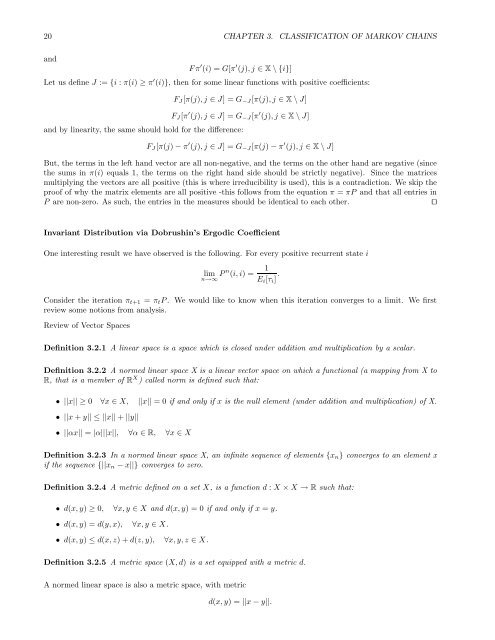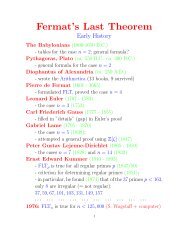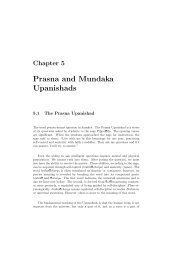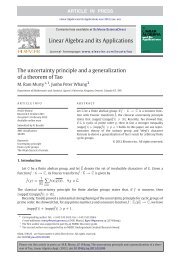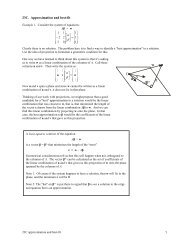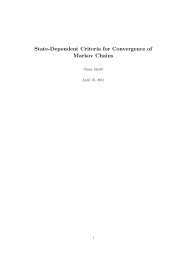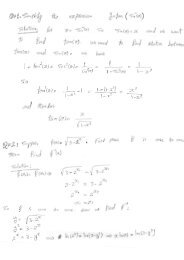Lecture Notes - Department of Mathematics and Statistics - Queen's ...
Lecture Notes - Department of Mathematics and Statistics - Queen's ...
Lecture Notes - Department of Mathematics and Statistics - Queen's ...
Create successful ePaper yourself
Turn your PDF publications into a flip-book with our unique Google optimized e-Paper software.
20 CHAPTER 3. CLASSIFICATION OF MARKOV CHAINS<br />
<strong>and</strong><br />
Fπ ′ (i) = G[π ′ (j), j ∈ X \ {i}]<br />
Let us define J := {i : π(i) ≥ π ′ (i)}, then for some linear functions with positive coefficients:<br />
F J [π(j), j ∈ J] = G −J [π(j), j ∈ X \ J]<br />
F J [π ′ (j), j ∈ J] = G −J [π ′ (j), j ∈ X \ J]<br />
<strong>and</strong> by linearity, the same should hold for the difference:<br />
F J [π(j) − π ′ (j), j ∈ J] = G −J [π(j) − π ′ (j), j ∈ X \ J]<br />
But, the terms in the left h<strong>and</strong> vector are all non-negative, <strong>and</strong> the terms on the other h<strong>and</strong> are negative (since<br />
the sums in π(i) equals 1, the terms on the right h<strong>and</strong> side should be strictly negative). Since the matrices<br />
multiplying the vectors are all positive (this is where irreducibility is used), this is a contradiction. We skip the<br />
pro<strong>of</strong> <strong>of</strong> why the matrix elements are all positive -this follows from the equation π = πP <strong>and</strong> that all entries in<br />
P are non-zero. As such, the entries in the measures should be identical to each other.<br />
⊓⊔<br />
Invariant Distribution via Dobrushin’s Ergodic Coefficient<br />
One interesting result we have observed is the following. For every positive recurrent state i<br />
lim P n (i, i) = 1<br />
n→∞ E i [τ i ] .<br />
Consider the iteration π t+1 = π t P. We would like to know when this iteration converges to a limit. We first<br />
review some notions from analysis.<br />
Review <strong>of</strong> Vector Spaces<br />
Definition 3.2.1 A linear space is a space which is closed under addition <strong>and</strong> multiplication by a scalar.<br />
Definition 3.2.2 A normed linear space X is a linear vector space on which a functional (a mapping from X to<br />
R, that is a member <strong>of</strong> R X ) called norm is defined such that:<br />
• ||x|| ≥ 0 ∀x ∈ X, ||x|| = 0 if <strong>and</strong> only if x is the null element (under addition <strong>and</strong> multiplication) <strong>of</strong> X.<br />
• ||x + y|| ≤ ||x|| + ||y||<br />
• ||αx|| = |α|||x||, ∀α ∈ R, ∀x ∈ X<br />
Definition 3.2.3 In a normed linear space X, an infinite sequence <strong>of</strong> elements {x n } converges to an element x<br />
if the sequence {||x n − x||} converges to zero.<br />
Definition 3.2.4 A metric defined on a set X, is a function d : X × X → R such that:<br />
• d(x, y) ≥ 0, ∀x, y ∈ X <strong>and</strong> d(x, y) = 0 if <strong>and</strong> only if x = y.<br />
• d(x, y) = d(y, x), ∀x, y ∈ X.<br />
• d(x, y) ≤ d(x, z) + d(z, y), ∀x, y, z ∈ X.<br />
Definition 3.2.5 A metric space (X, d) is a set equipped with a metric d.<br />
A normed linear space is also a metric space, with metric<br />
d(x, y) = ||x − y||.


